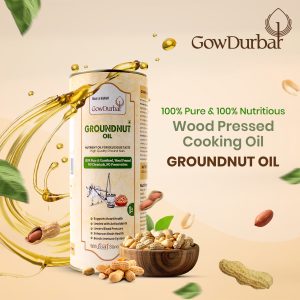Oils are regularly consumed items on our kitchen shelves. Many people don’t know there is a lot more to search and discover about daily consuming oils. Today Gowdurbar is here to help you find out the differences between genuine wood-pressed oils and normal oils available in the market.
Wood‑pressed groundnut oil is exactly that: oil squeezed gently from peanuts without high heat or harsh chemicals. Refined oils are processed to look clear and last long, but they often lose flavor and helpful nutrients along the way. This post explains why wood‑pressed groundnut oil is a smarter daily choice for Indian kitchens and how to use it well.
What “wood‑pressed” really mean?
Wood‑pressed extraction uses a slow, mechanical press that runs cool. Because the temperature stays low, delicate compounds like vitamin E, plant antioxidants, and the nutty aroma are better preserved. Refined oils usually go through heating, solvent extraction, bleaching, and deodorizing. Those steps make the oil neutral and shelf‑stable, but they flatten the taste and reduce the good stuff.
Heart‑friendly fats, minus the fuss
Groundnut oil naturally has more MUFA (monounsaturated fat), the same family of fats that makes olive oil popular. MUFA helps keep the overall fat profile balanced when used in place of saturated and trans fats. The wood‑pressed version sticks closer to the nut’s natural balance. In simple terms: it’s a clean, dependable base for daily meals like dal tadka, sabzis, dosas, or quick stir‑fries.
Antioxidants and vitamin E you can taste
A spoon of wood‑pressed groundnut oil brings a gentle nuttiness and a little vitamin E, which supports skin and cell protection. It’s not a magic pill, but compared to a neutral refined oil, you get more taste and a touch more nutritional value in every tadka. That means less need for heavy seasoning and a nicer aroma in the kitchen.
Better cooking experience at home
Refined oils may handle repeated, very high heat, but that’s not how most Indian homes cook every day. For regular sautéing, tempering, roasting, shallow frying, and pan‑toasting, wood‑pressed groundnut oil is very tasty. It warms quickly, carries spices beautifully, and doesn’t smell “industrial”. If planning a speedy deep‑frying for a festival, use fresh oil, avoid reheating again and again, and keep the flame moderate. For daily meals, wood‑pressed wins on flavor and feel.
Fewer additives, fewer worries
Because wood‑pressed oil skips solvent extraction and harsh treatments, it avoids residues that can come with heavy refining. You’re basically getting the oil, not a chemical formula set. That’s one less unknown in the pantry, which many families prefer.
Skin and hair gains as a bonus
Plenty of people use a little groundnut oil on dry spots or rough elbows because it’s naturally emollient and contains vitamin E. It’s not a replacement for a dermatologist, but if a cupboard item doubles up for small fixes, that’s a win.
Practical tips to get the most out of it
- Use it where flavour matters: tadka for dals, upma, poha, sabzi stir‑fries, egg bhurji, and roasting veggies.
- Store smart: keep the bottle tightly closed, away from heat and direct sunlight. A dark cabinet is perfect.
- Cook fresh: avoid re‑using the same oil many times. If it smells off or looks dark, retire it.
- Mix and match: rotating oils—groundnut, sesame, mustard, and coconut—keeps flavors interesting and the fat profile diverse.
Who will appreciate it most
- Home cooks who love a mild nutty aroma in tadka without a greasy aftertaste.
- Families trying to upgrade from highly processed pantry items to simpler, traditional choices.
- Folks who want a single oil that suits both North and South Indian dishes without clashing with spices.
Common concerns, answered
- Will the taste overpower food? No. Good wood-pressed groundnut oil smells nutty in the pan but stays gentle on the plate.
- Is it okay for high heat? Best for everyday cooking sauté, shallow fry, tempering. For repeated deep-frying, use fresh oil and avoid overheating.
- Is it healthier than refined oil? It keeps more natural antioxidants and has a pleasant MUFA profile. Health still depends on total diet and portion control.
A simple way to switch
Try replacing refined oil in one daily dish, say, your evening sabzi. Notice the aroma, the way spices bloom, and how the food feels lighter. Once comfortable, expand to dals, stir‑fries, and roasting. Most people don’t go back after a few weeks.
Conclusion
If the goal is cleaner and body-friendly ingredients, better flavor, and a kitchen that smells like real food, wood-pressed groundnut oil is a straightforward upgrade. It keeps more of the nut’s natural goodness, fits Indian cooking styles, and tastes great without effort.
FAQs
Q1: Can wood‑pressed groundnut oil help manage cholesterol?
A: It offers an MUFA‑rich profile that supports a better overall fat balance when used in moderation as part of a sensible diet. Lifestyle still matters—watch portions and stay active.
Q2: Is it safe for deep-frying?
A: It works for occasional deep-frying, but fresh oil and moderate heat are key. For routine deep‑frying, any oil degrades with repeated reuse, so keep an eye on color and smell.
Q3: Does cold‑pressed mean chemical‑free?
A: It means the oil is pressed mechanically at low heat without solvent extraction. That avoids the harsher steps used in many refined processes.
Q4: Will the flavor clash with spices?
A: No. The nutty note complements jeera, mustard, curry leaves, red chili, and garam masala. It lifts aroma rather than fighting it.
Q5: How should it be stored, and how long does it last?
A: Store in a cool, dark place with the cap tight. Use within the recommended shelf life on the label for the best taste and freshness.



